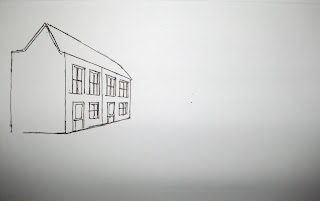What Is Perspective?
Perspective is the way that the
objects in a two dimensional image seems
to narrow as they recede into the background. Use of perspective can make a
flat, two dimensional image seem much less flat and more three dimensional. For
example, compare these two early sketches I made in 2016: -
Now, there’s nothing technically
wrong with the sketch on the top, which shows the side of the Pierhead Building
of the National Assembly in Cardiff. It’s as technically accurate as I’m ever
likely to be. But it’s very flat, and uninteresting, which is wrong, since the
Pierhead is a very interesting building. Bonmarche in Swansea is an interesting
building too, although nothing like the scale of the other. By positioning
myself some distance to the left of the shop, rather than directly in front of
the shopfront, I was able to use perspective to give an idea of the building in
its entirety, which I feel is a lot more interesting than the other sketch.
It's probably easier to talk about
perspective if I use a sketch example. Here’s a simple sketch of a house block.
Now, if I draw the other side of the street, I could position the block about the same distance from the vanishing point. However, if I move it further away, then the sightlines will be shallower. If I move the other block closer to the vanishing point, then the sightlines from the vanishing point would be much steeper, and the perspective more dramatic.
I do know people who like to set their vanishing point and sketch in sightline very thinly in pencil, then rub them out later. Personally, I don’t go to all that bother. I’m not trying to produce perfect photographic reproductions in my sketches. If I’m trying to portray a building with particularly dramatic perspective I may put a small dot on the page to represent the vanishing point if it’s on the page, but I draw my sightlines just with my eyes. More often than not the vanishing point is past the edge of the page, though.
None of the sightlines on the three
sketches were made using a ruler or straight edge. So it’s no surprise that
none of them are actually perfectly straight. However, they’re straight enough,
and the perspective is true enough to give me the effects I want, and
perspective I want. It’s a matter of practise, and being bold enough to
experiment. Try to always think where you want to put the vanishing point, and
the effect this will have on the viewpoint of the building. For example:-
Here’s the sketch prior to applying
watercolour to it: -See how far to the left the vanishing point would be. Probably not as far as you think. Actually, the perspective isn’t perfect on this – the lines between the bottom and the windows is a little too steep. One thing you might notice, though, is how low the vanishing point is. Using such a low vanishing point was a conscious decision, because I wanted to give the feeling of the viewer, looking up at the Theatre from further down the hill. It’s a derelict building, but the dramatic perspective works to give it a sense of the faded grandeur I eel every time I pass the building.











No comments:
Post a Comment